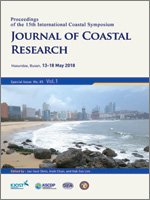Valentim, S.S.; Menezes, M.O.B., and Teixeira, C.E.P., 2018. Seasonally hypersaline estuaries in semiarid climate regions: an Example from the Northeast Brazil. In: Shim, J.-S.; Chun, I., and Lim, H.S. (eds.), Proceedings from the International Coastal Symposium (ICS) 2018 (Busan, Republic of Korea). Journal of Coastal Research, Special Issue No. 85, pp. 6–10. Coconut Creek (Florida), ISSN 0749-0208.
The Coreaú river estuary is located in Ceará state, Northeast of Brazil and it is a shallow system, dominated by meso tides and barred about 35 km upstream from its mouth. Generally, hypersaline estuaries are naturally found in arid and semi-arid regions of Brazil, but the blockage the natural flow of rivers by dam interference can also increase hypersaline conditions and residence time in these estuaries. This study examines the importance of water balance and dam interference to the circulation of the Coreaú river estuary, using observed data and Delt3D numerical simulations. Five discharge scenarios (with values from 0 to 300 m3s−1) were used in the Delft3D simulations to calculate the residence and flushing time in the estuary. Based on salinity data collected during two years the estuary was characterized as a hypersaline and well mixed system during the dry period (August to December) and a positive estuary during the wet season (January to June). The observed salinity along the estuary ranged from 37 g/kg to 44 g/kg in October, 2012 and from 37g/kg to 13g/kg in May, 2013, respectively near the mouth and 20 km upstream. Regardless of the discharge conditions and the atmospheric water balance, the estuary acquires hypersaline conditions during the dry season. Tidal circulation under all discharge conditions dominates the residence time in the first 10 km of the estuary. Water and materials from the upper region of the estuary depends on the river discharge to be transported to the shelf. Under all discharge conditions lower than 300 m3 s−1 the flushing time of the upper estuary is larger than 60 days. These fact associated with the high values of evaporation during the dry season explains the hypersalinization of the Coreaú estuary.





